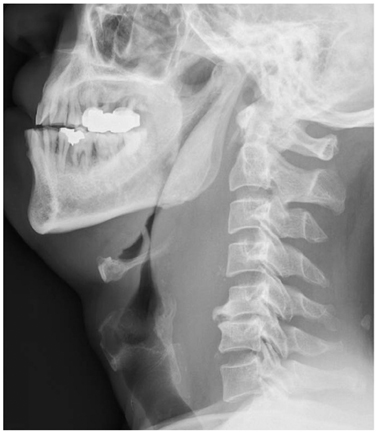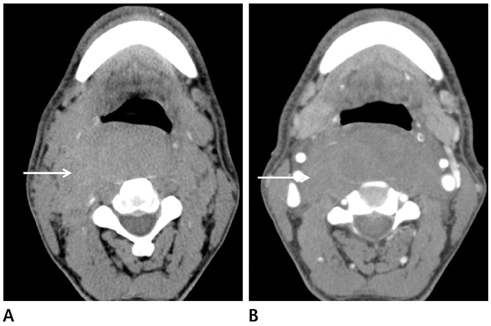J Korean Soc Radiol.
2014 Feb;70(2):87-91. 10.3348/jksr.2014.70.2.87.
Spontaneous Retropharyngeal Hematoma: A Case Report and Literature Overview
- Affiliations
-
- 1Department of Radiology, Haeundae Paik Hospital, Inje University College of Medicine, Busan, Korea. rjhrad@empal.com
- KMID: 1839417
- DOI: http://doi.org/10.3348/jksr.2014.70.2.87
Abstract
- A spontaneous retropharyngeal hematoma is a rare condition with a difficult diagnostic. This disease may rapidly progress to an airway obstruction. The author reports about a case of a 56-year-old man with an acute onset of sore throat, dysphonia and dyspnea. A retropharyngeal high attenuated soft tissue density could be seen on the neck CT. A rapid improvement of the retropharyngeal abnormality was seen on the 3 days follow-up MR imaging. Signal changes caused by blood products which were visible on the MRI images suggested the diagnosis of retropharyngeal hematoma. The patient was conservatively managed.
MeSH Terms
Figure
Reference
-
1. Bloom DC, Haegen T, Keefe MA. Anticoagulation and spontaneous retropharyngeal hematoma. J Emerg Med. 2003; 24:389–394.2. Muñoz A, Fischbein NJ, de Vergas J, Crespo J, Alvarez-Vincent J. Spontaneous retropharyngeal hematoma: diagnosis by mr imaging. AJNR Am J Neuroradiol. 2001; 22:1209–1211.3. Kang SS, Jung SH, Kim MS, Hong SJ, Yoon YJ, Shin KM. Spontaneous retropharyngeal hematoma - a case report -. Korean J Pain. 2010; 23:211–214.4. Findlay JM, Belcher E, Black E, Sgromo B. Tracheo-oesophageal compression due to massive spontaneous retropharyngeal haematoma. Interact Cardiovasc Thorac Surg. 2013; 17:179–180.5. Singh A, Ofo E, Cumberworth V. Spontaneous retropharyngeal haematoma: a case report. J Med Case Rep. 2008; 2:8.6. al-Fallouji HK, Snow DG, Kuo MJ, Johnson PJ. Spontaneous retropharyngeal haematoma: two cases and a review of the literature. J Laryngol Otol. 1993; 107:649–650.7. Akoğlu E, Seyfeli E, Akoğlu S, Karazincir S, Okuyucu S, Dağli AS. Retropharyngeal hematoma as a complication of anticoagulation therapy. Ear Nose Throat J. 2008; 87:156–159.8. Keats TE, Sistrom C. Atlas of Radiologic Measurement. 7th ed. St. Louis, MO: Mosby;2001. p. 121.9. Rojas CA, Vermess D, Bertozzi JC, Whitlow J, Guidi C, Martinez CR. Normal thickness and appearance of the prevertebral soft tissues on multidetector CT. AJNR Am J Neuroradiol. 2009; 30:136–141.10. Som PM, Curtin HD. Head and neck imaging. 4th ed. St. Louis, MO: Mosby;2003. vol 2:p. 1505p. 1562–1564.
- Full Text Links
- Actions
-
Cited
- CITED
-
- Close
- Share
- Similar articles
-
- Spontaneous Retropharyngeal Hematoma: A Case Report
- Cervical Prevertebral Hematoma - a Rare Complication of Acupuncture Therapy: A Case Report
- Acute Airway Obstruction by a Retropharyngeal Hematoma when Performing Internal Jugular Vein Cannulation in a Patient with HELLP Syndrome: A case report
- Traumatic Retropharyngeal Hematoma of Delayed Onset in an Anticoagulated Patient
- A Clinical Review on Four Cases of the Retropharyngeal Hematoma





